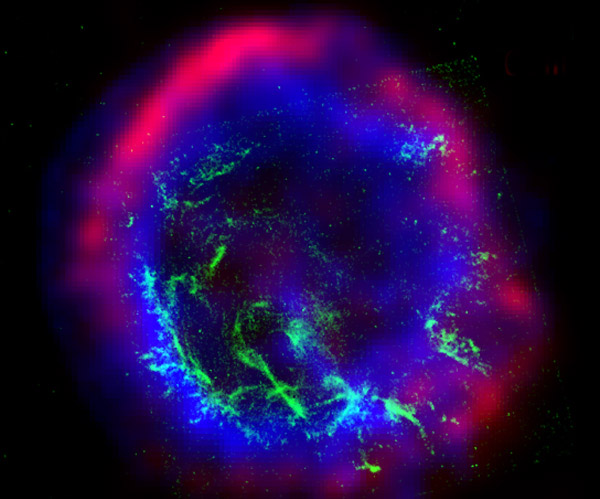Explanation: Not all stars form a big Q after they explode. The shape of supernova remnant E0102-72, however, is giving astronomers a clue about how tremendous explosions disperse elements and interact with surrounded gas. The above image is a composite of three different photographs in three different types of light. Radio waves, shown in red, trace high-energy electrons spiraling around magnetic field lines in the shock wave expanding out from the detonated star. Optical light, shown in green, traces clumps of relatively cool gas that includes oxygen. X-rays, shown in blue, show relatively hot gas that has been heated to millions of degrees. This gas has been heated by an inward moving shock wave that has rebounded from a collision with existing or slower moving gas. This big Q currently measures 40 light-years across and was found in our neighboring SMC galaxy. Perhaps we would know even more if we could buy a vowel.
1999 2000 2001 2002 2003 2004 2005 2006 2007 2008 2009 2010 2011 2012 2013 2014 2015 2016 2017 2018 2019 2020 2021 2022 2023 2024 2025 |
Yanvar' Fevral' Mart Aprel' Mai Iyun' Iyul' Avgust Sentyabr' Oktyabr' Noyabr' Dekabr' |
NASA Web Site Statements, Warnings, and Disclaimers
NASA Official: Jay Norris. Specific rights apply.
A service of: LHEA at NASA / GSFC
& Michigan Tech. U.
|
Publikacii s klyuchevymi slovami:
radio - supernova remnant - shock wave - supernova - ostatok Sverhnovoi - vzryvy sverhnovyh
Publikacii so slovami: radio - supernova remnant - shock wave - supernova - ostatok Sverhnovoi - vzryvy sverhnovyh | |
Sm. takzhe:
Vse publikacii na tu zhe temu >> | |
